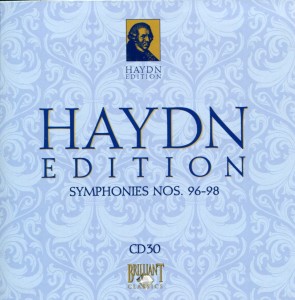 This morning at Panera, as I refilled my mug of Light Roast coffee, I overhead a group of old guys chatting in a little nook area near the front of the restaurant. One man, who looked to be in his mid to late 60s, had his laptop open and he was talking to guys who looked to be 10+ years older than that.
This morning at Panera, as I refilled my mug of Light Roast coffee, I overhead a group of old guys chatting in a little nook area near the front of the restaurant. One man, who looked to be in his mid to late 60s, had his laptop open and he was talking to guys who looked to be 10+ years older than that.
“Are you referring to Internet Explorer?” the man with the laptop asked. “Because I have Google Chrome and Firefox, too.”
I glanced over and looked at the gaggle of retirees and thought, “Really? Twenty years ago, guys of this age would be jawing about being retired – not about web browsers.”
Life is funny, innit?
Symphony No. 96 in D , “The Miracle Symphony,” was composed in 1791 and is part of the London Symphonies. It is called “The Miracle Symphony” because, according to its entry on Wikipedia,
It is so called due to the story that, during its premiere, a chandelier fell from the ceiling of the concert hall in which it was performed. The audience managed to dodge the chandelier successfully as they had all crowded to the front for the post-performance applause, and the symphony got its nickname. More careful and recent research suggests that this event did indeed take place but during the premiere of his Symphony No. 102.
Haydn was 59, when this symphony was composed and first performed.
Symphony No. 97 in C was composed and first performed in 1792. Haydn was 60 years old. An interesting fact about this symphony:
First published in England, it made its way to the continent a few years later and was used by Ludwig van Beethoven as a model for a symphony in C major he never completed, and by Friedrich Witt for the Jena Symphony.
Symphony No. 98 in B Flat was also composed and performed in 1792, however it was first performed on March 1, 1792. Haydn’s birthday was March 31st. So he wasn’t quite 60.
A very interesting tidbit about Symphony No. 96:
The symphony’s scoring is singular among Haydn’s later symphonies. It requires an obligato part for harpsichord, which has a prominent eleven-bar solo passage near the end of the finale. Although the harpsichord was often used as a continuo or solo instrument, it was rarely given a prominence of this kind in purely orchestral works. Most likely, Haydn himself played the harpsichord at the premiere.
Can you imagine that? Haydn playing in his own symphony? (The harpsichord can be heard at about the 7:40 mark in Movement IV (“Finale: Presto”). It’s faint, though. So you have to listening closely.
 The harpsichord is an interesting instrument. Nothing makes me think of the 17th century like the harpsichord. It has an immediately recognizable sound and is, I have discovered, best enjoyed in small doses. Here’s a picture of one.
The harpsichord is an interesting instrument. Nothing makes me think of the 17th century like the harpsichord. It has an immediately recognizable sound and is, I have discovered, best enjoyed in small doses. Here’s a picture of one.
I once tried to listen to the complete compositions of J.S. Bach and couldn’t get through more than the first dozen CDs or so because they were performed on period instruments, with harpsichord playing a major role. In short order, that instrument grated on me like fingernails on a chalkboard. I had to abandon my project until I found a complete Bach set that used modern instruments (piano in place of harpsichord, for example). I did. And that’ll be explored in the last year of my Three-Year project.
If you’d like to see Haydn Symphony No. 98 in B Flat performed, take a look below. This is the great Leonard Bernstein conducting the New York Philharmonic.
The harpsichord solo in the fourth movement begins at the 31:23 mark. (NOTE: It’s not Haydn playing the harpsichord.)

I can’t even imagine seeing Haydn performing a symphony in person, though I imagine it’s a bit like watching Paul McCartney perform Hey Jude live. Unbelievable that you’re hearing this legendary guy perform this legendary song that he wrote, and he’s right there in front of you.